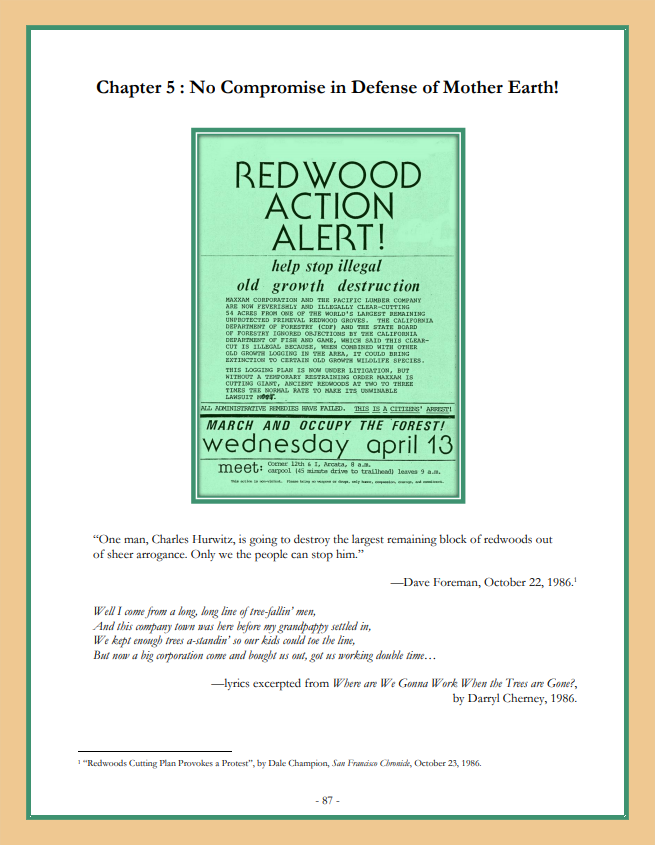By Steve Ongerth - From the book, Redwood Uprising: Book 1
Download a free PDF version of this chapter.
“One man, Charles Hurwitz, is going to destroy the largest remaining block of redwoods out of sheer arrogance. Only we the people can stop him.”
—Dave Foreman, October 22, 1986.[1]
Well I come from a long, long line of tree-fallin’ men,
And this company town was here before my grandpappy settled in,
We kept enough trees a-standin’ so our kids could toe the line,
But now a big corporation come and bought us out, got us working double time…
—lyrics excerpted from Where are We Gonna Work When the Trees are Gone?, by Darryl Cherney, 1986.
On the surface, very little seemed to have changed in Scotia for its more than 800 residents, but deep down, they all knew that the future was very much uncertain. Some seemed unconcerned, such as 18 year Pacific Lumber veteran Ted Hamilton, who declared, “We’re just going on as always,” or his more recently hired coworker, millworker Keith Miller, who had been at the company less than six years and who stated, “It doesn’t bother me much.”[2] Indeed, many of the workers seemed to welcome their newfound financial prosperity. [3] However, there were at least as many workers whose assessments were quite pessimistic, including millworker Ken Hollifield, a 19 year veteran who opined, “I’m sure this place won’t be here in five to seven years.” Former millworker and then-current owner of the Rendezvous Bar in Rio Dell, George Kelley, echoed these sentiments stating, “For 2½ years they’ve got a good thing going. After that they don’t know what’s happening.” Dave Galitz dismissed the naysayers’ concerns as typical fear of change, but careful estimates of the company’s harvesting rates bore out the pessimistic assessments. In the mills and the woods, however, production had increased substantially, to the point that many were working 50 and 60 hours per week. If there was to be any organized dissent, it would be difficult to keep it together, because the workers had little time to spare.[4] There seemed to be little they could do outside of a union campaign, and the IWA had neither been inspiring nor successful in their attempt.
Deep in the woods however, the changes were readily obvious. In 1985, the old P-L had received approval from the California Department of Forestry (CDF) to selectively log 5,000 acres.[5] With John Campbell at the helm, under the new regime, the company filed a record number of timber harvest plans (THPs) immediately following the sale, and all of them were approved by the CDF. There was more than a hint of a conflict of interest in the fact that the director of the agency, Jerry Pertain, had owned stock in the old Pacific Lumber and had cashed in mightily after the merger. [6] Since the takeover, the new P-L had received approval to log 11,000 acres, 10,000 of which were old growth, and there was every indication that these timber harvests would be accomplished through clearcutting.[7] Pacific Lumber spokesmen who had boasted about the company’s formerly benign forest practices now made the dubious declaration that clearcutting was the best method for ensuring both long term economic and environmental stability.
P-L forester Robert Stephens claimed that the old rate was unsustainable anyway, declaring, “About five years ago, it became apparent that there is going to be an end to old-growth. We simply cannot operate on a 2,000 year rotation.”
Public affairs manager David Galitz repeated what would soon become the new regime’s gospel, that clearcutting had actually been in the works for some time before the hint of a merger, even though in actual fact, this was untrue.
Pacific Lumber’s logging operations which had hitherto been idyllic by comparison now outpaced those of even Louisiana-Pacific and Georgia-Pacific. They tripled their logging crews, bringing in loggers from far away who had never known the old Pacific Lumber and had no particular loyalty to the fight to prevent Hurwitz’s plunder of the old company. [8] Most of the new hires were gyppos, and there were rumblings among the old timers that the quality of logging had decreased precipitously. In John Campbell’s mind, such inefficiencies were likely to be temporary and any small losses that occurred were more than offset by the much larger short term gain. The expense to the viability of the forest, however, was never entered into the ledger.[9] One resident who lived very close to the border of Pacific Lumber’s land relayed their impressions, writing:
“I live at the end of (the) road in Fortuna. Maxxam’s Pacific Lumber logging trucks drive by our house six days a week now. (It has) never been like this in the past. Ordinarily, logging was five days a week in summer…
“From Newberg Road you can look up and see the damage they are doing to the badly eroding hills, now bare of third growth. They are logging third growth from their graveled road now. As the trucks come by, it is amazing to see how small their (logs are), like flagpoles.
“What will be the value of their property when all of the trees are gone? Are they trying to eliminate all other competition—L-P, Simpson, etc.—as their long-range goal?”[10]
Environmentalists expressed alarm and outrage at the sweeping and regressive changes that had been instituted now that Hurwitz had assumed control of Pacific Lumber. John DeWitt, executive director of Save the Redwoods League, the organization that had been instrumental in coaxing the Murphy Dynasty to adopt sustainable logging practices in the first place, expressed these fears stating, “We thought they practiced excellent forestry over the past 125 years and deplore the fact they’ll double the cut. It may result in the ultimate unemployment of those who work at Pacific Lumber.”